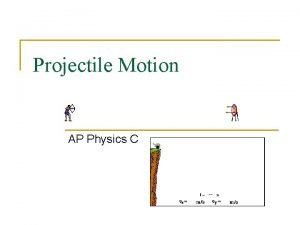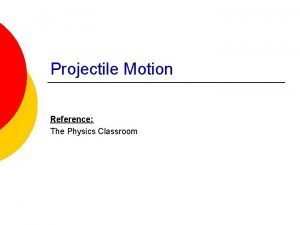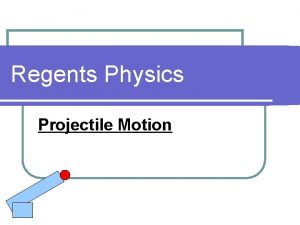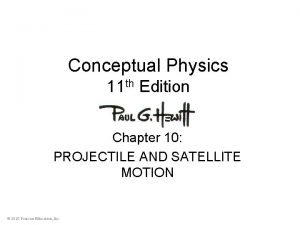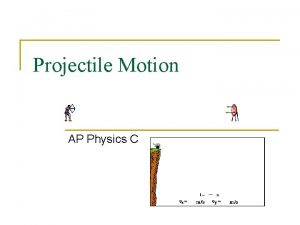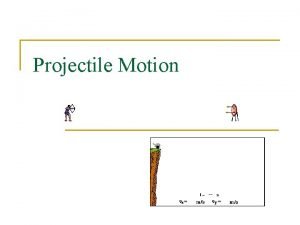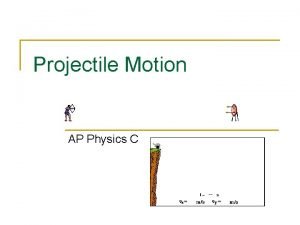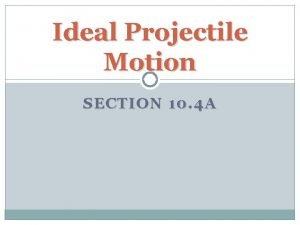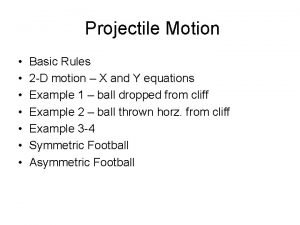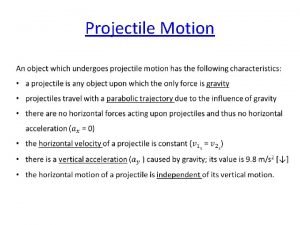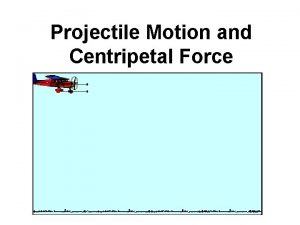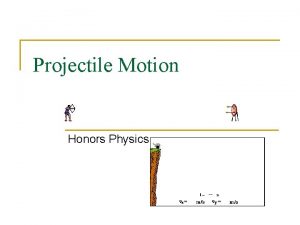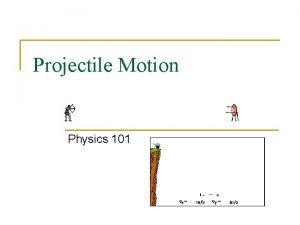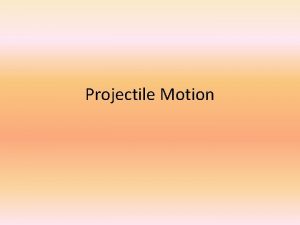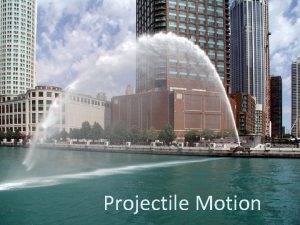Projectile Motion AP Physics C Projectile Motion Projectile



















- Slides: 19

Projectile Motion AP Physics C

Projectile Motion § Projectile motion is an extension to two dimensions of free-fall motion. § A projectile is an object that moves in two dimensions under the influence of gravity and nothing else. § As long as we can neglect air resistance, any projectile will follow the same type of path. § The path of a projectile looks like a parabola!

A Simple Experiment Consider the following experiment: We take two identical bullets and load one of them into a gun. Starting both bullets from the same height, we simultaneously fire one bullet and drop the other. If the fired bullet was shot horizontally, which bullet will strike the ground first?

What the What? !? § THEY HIT AT THE SAME TIME! § This fact teaches us a very important concept behind projectiles: The vertical and horizontal motion of a projectile are INDEPENDENT of each other. § The projectile does not “know” if it is being launched or dropped, nor does it care. The horizontal and vertical motion do not affect one another. § Because of this, we will analyze projectiles in the horizontal and vertical directions separately. § This means that we will be breaking vectors (mostly velocity) into “x” and “y” components.

Horizontal Velocity Component § The projectile covers equal horizontal displacements in equal time periods. This means the initial horizontal velocity equals the final horizontal velocity. § In other words, the horizontal velocity is constant. BUT WHY? § The projectile only accelerates because of gravity, which points down. Because of this, the horizontal component of velocity is unaffected. § The acceleration of a projectile in the horizontal direction is 0!

Vertical Velocity Component § There is acceleration in the vertical direction, which means that a projectile does not cover equal displacements in equal periods of time. § For a projectile launched at an angle, both the magnitude and direction of the vertical velocity change. § On the way up, the vertical velocity decreases in magnitude. § At the very top of the flight, the vertical velocity is equal to 0 (this is a very important aspect of projectiles that can make the math much easier). § On the way down, the vertical velocity points down and increases in magnitude.

Return of the Kinematics § Because projectile problems focus mostly on position, velocity, acceleration and time, we will use our kinematic equations to analyze projectile motion. § The process is much the same as with 1 -D kinematics problems, only now we may have to analyze the horizontal and vertical direction in a single problem.

Horizontal Launch § This is the simplest kind of projectile that you can have. § For a horizontally launched projectile, we will always know a few things: § The initial y velocity is equal to 0. § The x velocity is constant.

Time of Flight – Horizontal Launch § A common projectile question is to ask for the time of flight for a horizontally launched projectile. § Given that the initial y velocity is equal to 0 for such a launch, we can simplify the second kinematic to solve for time. § This is ONLY FOR HORIZONTAL LAUNCH. Don’t use it for a launch at an angle. § g is 9. 8 m/s 2, don’t add an extra negative to this equation. If you do that you end up with an imaginary number for your time. Lets not do that.

Example A plane traveling with a horizontal velocity of 100 m/s is 500 m above the ground. At some point the pilot decides to drop some supplies to designated target below. (a) How long is the drop in the air? (b) How far away from point where it was launched will it land?

Projectiles at Angles § Projectiles can also be launched at angles, which requires a little more care than if launched horizontally. § Unlike with a horizontal projectile, we DO have an initial vertical velocity when launched at an angle. § Because of this we will generally have to start by breaking up the initial velocity into vertical and horizontal components. § Angled projectiles can be launched either ground to ground (no net elevation change), or elevated launch.

Understanding the Acceleration Vector § § Acceleration vectors always point in the direction that a velocity vector is changing. You can break the acceleration vector up into 2 components; one that is parallel to velocity and one that is perpendicular. § The parallel component is responsible for changing speed. § The perpendicular component is responsible for changing direction.

Breaking Up Initial Velocity § Breaking up the initial velocity into horizontal and vertical components allows us to make our list of known and unknown values. § All we need to break up the velocity is the launch speed and the angle of launch. § Use trigonometry to find the horizontal and vertical components.

Ground to Ground (GTG) Launch § If a projectile is launched from a certain height and comes back down to that same height, we can use the symmetry of flight to analyze the motion. § Because the y velocity is 0 at the top of the flight (often called the apex), we can break the problem into on the way up, and on the way down. § When working with a GTG projectile, it is often easiest to define the ground to be a height of 0.

Range of a GTG Launch § The range of a projectile is the horizontal distance traveled. § Without air resistance, the maximum range for a projectile is achieved at a 45° launch angle. § You can use the equation below to calculate the range of a projectile, but only if it is GTG!

Elevated Launch § Angled projectiles can also have a launch height that is different from the landing height. § For these kinds of launch it is often easiest to define the lowest point on the path to be a height of 0. This prevents us from having a negative position. § These kinds of problems do not show up often, so there will not be a heavy emphasis on them.

Example A place kicker kicks a football with a velocity of 20. 0 m/s and at an angle of 53 degrees. (a) How long is the ball in the air? (b) How far away does it land? (c) How high does it travel?

Example Projectiles 1 and 2 are launched over level ground with the same speed but at different angles. Which hits the ground first? Ignore air resistance. Projectiles 1 and 2 are launched over level ground with different speeds. Both reach the same height. Which hits the ground first? Ignore air resistance.

One More Experiment A hunter is walking through the jungle when he sees a monkey hanging from a tree branch. The hunter decides he wishes to subdue the monkey to take him home and teach him the fundamentals of quantum field theory. However, right as the hunter pulls the trigger (it’s a tranquilizer, no monkeys were harmed in the making of this hypothetical scenario), the monkey lets go of the tree branch. In order to hit the monkey, does the hunter need to aim right at the monkey, below the monkey, or above the monkey?
 Physics javelin projectile motion
Physics javelin projectile motion How to calculate projectile motion
How to calculate projectile motion Tennis ball in motion
Tennis ball in motion The physics classroom projectile motion
The physics classroom projectile motion Projectile motion regents questions
Projectile motion regents questions Vyi physics
Vyi physics What is vyf in physics
What is vyf in physics A projectile has a single force that acts upon it
A projectile has a single force that acts upon it Conceptual physics projectile motion
Conceptual physics projectile motion Ap physics
Ap physics Projectile motion ap physics
Projectile motion ap physics Vertical velocity formula
Vertical velocity formula Modern physics vs classical physics
Modern physics vs classical physics University physics with modern physics fifteenth edition
University physics with modern physics fifteenth edition Ib physics ia examples
Ib physics ia examples Projectile motion definition
Projectile motion definition Ideal projectile
Ideal projectile Projectile motion rules
Projectile motion rules Projectile motion
Projectile motion Vertical y horizontal
Vertical y horizontal
